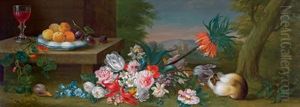Heinrich Christoph Piccard Paintings
Heinrich Christoph Piccard, often less known in the general history of art, was a German engraver and ivory turner who lived during the Baroque period. Born in 1680, Piccard was part of a family of artists and craftsmen, which was not uncommon in the Europe of his time, where artistic skills were frequently passed down through generations. The Piccard family was originally from France but moved to Germany, where they became established in Augsburg.
Heinrich Christoph Piccard's work mainly involved intricate ivory turning, a craft that required exceptional skill and precision. During the Baroque period, the demand for such luxury items was high among the European aristocracy, who prized them as collectibles and used them to decorate their lavish homes. Piccard's engravings, on the other hand, were detailed and often incorporated themes popular in the Baroque era, such as mythological and religious imagery.
Despite the fact that detailed records about Piccard's life are scarce, it is known that he was active during a time when Augsburg was a significant center for the arts and crafts. The city was renowned for its goldsmiths, painters, and other artisans. Piccard's contributions would have been part of this vibrant artistic environment, which was influenced by both local traditions and the broader European artistic movements of the time.
Heinrich Christoph Piccard passed away in 1764. While his name might not be as recognizable as those of his contemporaries, his work remains a testament to the skill and artistry of ivory turners and engravers of the Baroque period. Examples of his craftsmanship would likely be found in museum collections that specialize in decorative arts from this era.
